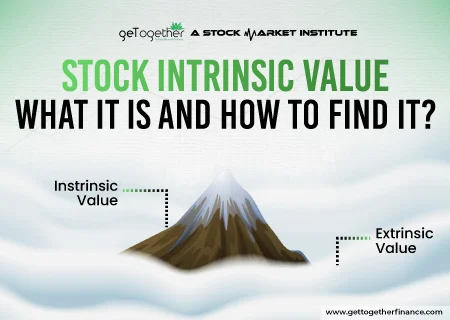Stock Intrinsic Value: What It Is and How to Find It?


Table of Contents
ToggleIntroduction
Are you an investor who buys stocks based on hearsay, trends, and TV experts? Well, it may work sometimes, but you are on your own on the volatile turf of the stock markets. Without understanding how the stock markets function, you can end up losing a fortune. So, what’s the solution? Let’s introduce you to value investing.
You must have heard about the greatest stock investor of our era, Warren Buffett. What made him stand out and become the wealthiest investor? Value investing.
As an investor, you should always look to broaden your horizon for picking the right stocks. Limiting it to mere technical analysis can be detrimental to your capital. Instead, you should couple it with fundamental analysis and identify the real value of a stock. It means you should determine what the stock is actually worth by calculating the stock’s intrinsic value.
In this blog, we discuss value investing in detail. You will learn about the various stock valuation models and how you can use them to arrive at the intrinsic value of a stock.
What is Intrinsic Value?

In layman’s terms, you would consider the market price of a stock as its value. But it is not true. The market price includes several factors like premium, investor sentiments, trading actions, broader economic trends, market volatility, etc. In such a scenario, how can you know about the true value of a company unadulterated by the impact of market fluctuations?
Here comes the concept of stock intrinsic value. It represents the true worth of the stock. You can compare this to the current market price of the stock and identify undervalued stocks. This exercise will help you select and invest in valuable stocks. Hence, the name value investing, which is the key pillar of Warren Buffett investing principles.
Now the question arises, what is the difference between intrinsic value and market value?
Intrinsic Value vs Market Value
| Features | Intrinsic Value | Market value |
| Calculation | Calculated using fundamental analysis values and stock valuation models. | The current trading price of the stock is the market value. |
| Influenced by | Fundamentals of a company, like financial health, revenue, profits, assets, etc. | Demand and supply, market sentiment, latest news, economic trends, etc. |
| Stability | As it depends on performance, a stock’s intrinsic value is relatively stable. | The market price of a stock is highly volatile. |
| Use | It is used in fundamental analysis by long-term investors. | It is used for technical analysis by short-term traders and speculators. |
Read More – What is Market Capitalization in the stock market?
Why Intrinsic Value Matters to Investors?

By now, you have a basic understanding of the concept of value investing. But why is the intrinsic value of a stock so important for investors? How does knowing the intrinsic value empower you and give you an edge over other investors? Let’s see:
- Identify underpriced stocks: When the market price is lower than the intrinsic value, it means the stock is undervalued, and you should buy it if the company has strong fundamentals. This means you can get value from investing in this stock.
- Practice value investing: While trading with technical analysis can be thrilling and charming, to create real wealth, you should practice value investing. Buy a stock with high intrinsic value and hold your position in the long term to capitalize on price appreciation.
- Think long-term: It requires patience to slowly but steadily see your wealth grow. But most of us want to get rich instantly and take unnecessary risks. Instead, you should think long term, and value investing is the answer.
- Avoid emotional investing: Emotional buying and selling lead to more losses. You should stay away from speculation based on false hypes.
Common Methods to Calculate Intrinsic Value

We have been talking about the models for calculating stock intrinsic value throughout the blog. Let’s take a look at some of the popular methods investors use for identifying the ideal stocks for value investing:
Discounted Cash Flow (DCF) Analysis
The most widely used method is the DCF model, or the discounted cash flow model. It is also called the free cash flow (FCF) model. This is because this method tracks the cash flows that are purely earned by a business after accounting for all the expenses and provisions.
Based on the past data, future cash flows are projected and then discounted to bring them to the present value. Here’s the DCF model intrinsic value formula, which will give you a better perception of what’s happening:
| Intrinsic Value=CFt(1+r)t+TV(1+r)nCFt = Cash Flow in the year t.TV = Terminal Valuer = Discount Rate (Usually, the weighted average cost of capital (WACC) of a company is used as the discount rate)n = Number of yearsFor example, if we need to calculate the Intrinsic value for 5 years using the DCF model, the formula becomes:CF1(1+r)1+CF2(1+r)2+CF3(1+r)3+CF4(1+r)4+CF5(1+r)5+TV(1+r)5You can see how the formula expands to account for the discounted values of all the cash flows.Remember, we assume 2 things in the DCF model:Going ConcernEstimated Future Cash Flows |
Dividend Discount Model (DDM)
Some companies have maxed out on their capacities and are cash-rich. So, instead of ploughing back the profits, they distribute regular dividends to stockholders. This ensures price stability, builds investor trust, and provides a regular income stream to them. If you invest in such a share, the actual value lies in the dividend payout. Hence, we use the Dividend Discount Model (DDM) in such cases for value investing.
The intrinsic value formula with the DDM model is:
| Intrinsic Value=D1r-gD1 = Next Year Dividendr = Discount Rateg = Dividend Growth RateHere are the things we assume while applying the Dividend Discount Model:The company will pay regular dividends perpetually.The dividends will keep growing at a steady rate perpetually.The next year’s dividend is calculated by adjusting the current dividend for the growth rate.The discount rate remains the same perpetually.Note: This formula can be used to calculate the present value of any perpetuity. |
Asset-Based Valuation
The companies that hold significant tangible assets like factories, buildings, etc, are valuable because of the value appreciation of these assets. To determine the intrinsic value of such stocks (or Net Asset Value), it is a better option to use an asset-based valuation.
The intrinsic value formula for this model is simple:
| Net Asset Value (NAV)=Assets-LiabilitiesThis NAV can also be used to calculate the Book Value Per Share (BVPS), which is commonly used as an intrinsic value indicator. You can calculate it by simply dividing the NAV by the outstanding number of equity shares. |
Factors that Influence Intrinsic Value

Is a stock’s intrinsic value absolute, or does it get affected by different elements that play a role in determining the value of the stock? Let’s explore the factors on which the stock valuation is dependent.
- Company Fundamentals: The current fundamental numbers of the company make a huge impact on the future projections. Be it revenue, growth, profit margins, debt servicing, or any other metric, it is used to calculate the intrinsic value for fundamental analysis.
- Growth Potential: The biggest economic concept in the corporate world is economies of scale. The faster a company can scale its operations, the higher its stock intrinsic value is.
- Risk Profile: Risk and returns go hand in hand. If a business carries more risk, the cost of capital will be high. It is obvious to have a higher discount rate for the DCF calculation.
- Cost of Capital: A lower cost of capital positively affects the intrinsic value by increasing the present value of discounted cash flows.
- Economic Environment: The macroeconomic factors, like interest rates, inflation, market trends, etc, play a pivotal role in the stock valuation.
Intrinsic Value in Practice: Real-World Example

The most popular method of stock valuation is the DCF model. In order to understand the concept better, let’s take an example.
Suppose Company A currently expects a free cash flow of Rs. 100 crore per annum. The cash flow is projected to grow at 5% p.a. For the next 5 years. Beyond that, the growth rate is assumed to be 3% p.a. We have to find the stock’s intrinsic value, provided the discounting factor is 10% p.a.
As you can see, there are 2 sets of growth projections. One for the first 5 years and thereafter for perpetual growth. So the cash flows will be as follows:
| Years | Free Cash Flows | Present Values @ 10% |
| Year 1 | 100 Crores | 100 Crores |
| Year 2 | 105 Crores (+5%) | 95.45 Crores |
| Year 3 | 110.25 Crores (+5%) | 91.11 Crores |
| Year 4 | 115.76 Crores (+5%) | 86.97 Crores |
| Year 5 | 121.55 Crores (+5%) | 83.02 Crores |
| Year 6 | 125.20 Crores (+3%) Perpetuity |
Let’s apply the formula:
| Intrinsic Value=CFt(1+r)t+TV(1+r)nIntrinsic Value=100+95.45+91.11+86.97+83.02+178.86(1.10)6Intrinsic Value=Rs. 557.50 Crores |
Now, suppose the market value of the stocks of Company A is Rs. 500 Crores. This means the stock is undervalued by Rs. 57.50 Crores and you should invest in it for atleast 10%+ returns.
Limitations of Intrinsic Value Models

Even though intrinsic value is regularly used in fundamental analysis, it has certain limitations. There are:
- There are a lot of assumptions and projections, and the slightest change can affect the results widely.
- The discount rates and growth rates you assume are sensitive and have a major impact on the end result.
- It is more suitable for established companies. Startups with unstable cash flows should be valued differently.
- It ignores the impact of trends and market sentiments, leading to its irrelevance for short-term trading.
Conclusion
If you really want to grow your wealth with the stock markets, who better to follow than the legend himself? To become the next Warren Buffett or Rakesh Jhunjhunwala, you need to start value investing. Conducting regular technical and fundamental analysis is the key to making the right investment decisions. Use the stock intrinsic value to identify undervalued stocks and invest with the long-term objective. Happy investing!



 Instagram
Instagram
